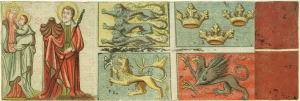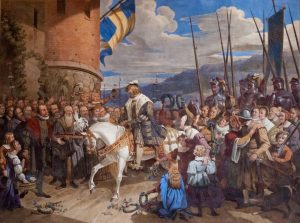Welcome to this roll-up exhibition about the Reformation in Finland! Finland is today a country where the majority of people are Lutherans. During the Reformation period, however, it was not clear whether Finland would become Lutheran or not – there were even times when Finland might have returned to Catholicism. To understand the Finnish Reformation, we must start our journey in the Middle Ages, when Finland was Catholic and part of the Swedish realm.
Finland – a country between east and west
Christianisation in Finland happened gradually, first through commerce and cultural contacts and then probably by individual missionaries. The Church established a parish structure in Western Finland in the middle of the 12th century, and at the same time Finland was annexed to the Swedish kingdom.

Engraving showing the first crusade to Finland, during which the Finns were supposedly converted to Christianity. Wikimedia Commons.
The area of Finland was disputed between Sweden and Novgorod, (an early Russian city state), and between the Roman Catholic and Eastern Orthodox Churches. During the Middle Ages, Finland became an integral part of Sweden and Catholicism became the predominant religion. In the Eastern parts of Finland, however, the Eastern Orthodox Church retained its dominant position, and the Orthodox Church has still an official position in Finland.
Turku was the political and ecclesiastical capital of Finland, with the episcopal see and the cathedral chapter residing there. It was the second largest city in the Swedish realm by the end of the Middle Ages, and had tight economic connections to the Hanseatic towns in the Baltic Sea region.
The Kalmar Union

A ship flag from of the Kalmar Union period with the coats of arms of Denmark, Sweden, Norway and Pomerania. Illustration by Julius Magnus Petersen, 1882. Wikimedia Commons.
From 1397, Sweden was a part of the Kalmar Union, which united under a common monarch the kingdoms of Sweden, Denmark and Norway. However, the Union was in an almost constant state of turmoil from the death of Queen Margaret I in 1412, because Sweden and Denmark had different interests in international politics. In Sweden, there were many rebellions against the Danish-led alliance during the 15th century. In 1520 the King of Denmark, Christian III, finally reconquered Stockholm, the capital of Sweden. During his coronation ceremonies, he executed many Swedish nobles in an event known as the Stockholm bloodbath.
This resulted in yet another rebellion against the Danes, led by the young noble Gustav Vasa. He managed to

The triumphant Gustav Vasa enters Stockholm in 1523. Painting by Johan Gustaf Sandberg. Wikimedia Commons.
beat Denmark, release Sweden from the Kalmar Union and secure the Swedish crown for himself by 1523. Even as a crowned king the situation was all but easy for Gustav Vasa. He had used immense amounts of money in the war, and the state was in heavy debt to the Hanseatic city of Lubeck. In addition, Vasa was not the only one interested in the Swedish crown, and he had many rivals in the Swedish aristocracy. In this situation, the wealthy Catholic Church with its powerful bishops seemed to be a serious threat to Gustav Vasa.
Leave a Reply